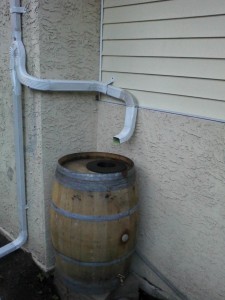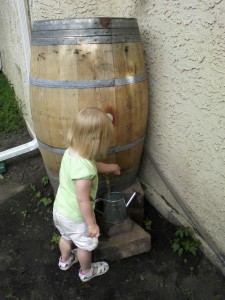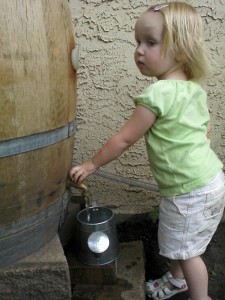When the newsletter from our local co-op arrived in the mail in late May, I perused the list of classes, as I often do. There are usually one or two interesting classes, but I had never taken one.
But this time, I saw a rain barrel class scheduled for early June. The class would discuss the importance of capturing rain water, its uses and benefits, and how to go about capturing said water. After a one hour class, participants would go outside and make their own rain barrel. Well, maybe “modify” would be a better word than “make,” as the barrels were already sitting out in the yard waiting for us, but we did have to drill some holes and install some hardware.
The class was offered in three price brackets. I chose the highest-priced option, as that allowed me to have one of the oak barrels (the other two were plastic and butt-ugly). The oak barrels had formerly been used to store wine, so they had some burgundy stains on them and a bung hole where, previously, the delicious nectar had been transmitted. In fact,
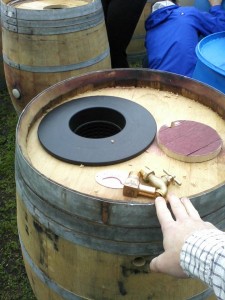 the barrel gave off a strong, intensely pleasant aroma as soon as I drilled the first pilot hole in the top.
the barrel gave off a strong, intensely pleasant aroma as soon as I drilled the first pilot hole in the top.
Besides the hole for the rain water to enter, I also had to drill two holes on the side of the barrel; one for overflow, and one for the spigot. We were all instructed to be careful to drill in the center of a stave. Drilling a hole that straddles two staves, we were warned, could split the staves and cause leakage. I’m happy to report I successfully drilled in the center of a stave each time, which is more than I can say for some of my classmates. You can see the hole for the overflow spigot near my thumb in the photo at left.
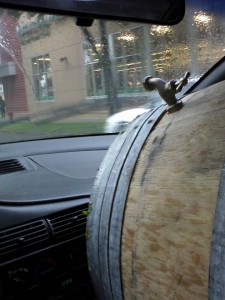 After driving the barrel home (it just barely fit in the passenger side of my Cavalier; I had to lower the seat as far as possible), it sat in my garage for a couple weeks until I purchased and installed all the necessary parts for redirecting my gutter. If you read my last blog post, and the one before that, you’ll see that I’ve done quite a bit of traveling in the past month, so I worked on this project intermittently when I was at home.
After driving the barrel home (it just barely fit in the passenger side of my Cavalier; I had to lower the seat as far as possible), it sat in my garage for a couple weeks until I purchased and installed all the necessary parts for redirecting my gutter. If you read my last blog post, and the one before that, you’ll see that I’ve done quite a bit of traveling in the past month, so I worked on this project intermittently when I was at home.
I could have just cut the gutter at an appropriately high spot and dropped the barrel in place there, but duing the class, the instructor showed us pictures of a rain diverter. ![downspout_diverter_abpDDy_350w[1]](http://zimmerscope.com/Verbisaurus/wp-content/uploads/2013/07/downspout_diverter_abpDDy_350w1-150x150.png)
I wanted that for two reasons: 1) The barrel needs to be stored in the garage in the winter, but since there’s still the possibility of rain (and melting snow) during any month, I wanted this water to still be shunted away from my house, and not come pouring down in a big, muddy mess right by my foundation. And, 2) my house narrows right near the downspout, and I thought this alcove would create a perfect spot for the barrel to tuck into, but I’d have to wrap the gutter around this corner.
In this photo at left, you can see the fruits of my labor. The gutter travels down the side of the house like it always did, but then it splits in two with the diverter. The split going to the left simply curves back in and then goes straight down like it did before. The split to the right, meanwhile, follows around the two corners of the house and then spits out directly above the barrel. The silver lever in the diverter allows me to select the path I wish the water to follow. In the winter, when I remove the barrel, I will switch the diverter to allow the water to travel straight down.
In this photo you can also see the overflow tube (lower right), which is attached to the top spigot and follows along the side of the house for about five feet until it comes to a rock garden, where I have it covered by rocks, and then spits out into my yard just in front of a stone wall.
These two photos feature the latest model of Zimmerman filling her watering can to go water the rose bushes. As you can see, it’s so easy, even a two-year old can do it. (Well, an above-average two-year old can do it, at any rate.)
The act of filling a watering can is very enjoyable, evidently, and Isla can hardly resist sticking her hand into the can as it fills, even though she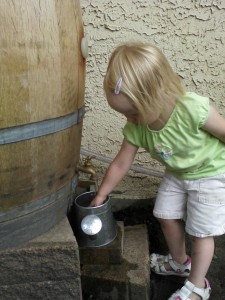 really should be focusing on turning off the spigot before the can overflows.
really should be focusing on turning off the spigot before the can overflows.
The first time she and her brother used the barrel, I saw her drinking from her watering can.
“Isla! Don’t drink that water,” I said, “It’s dirty.”
“But it smells like beer,” she said, noting the wine-aroma that is still subtely present even a month after drilling holes and filling it with water.

